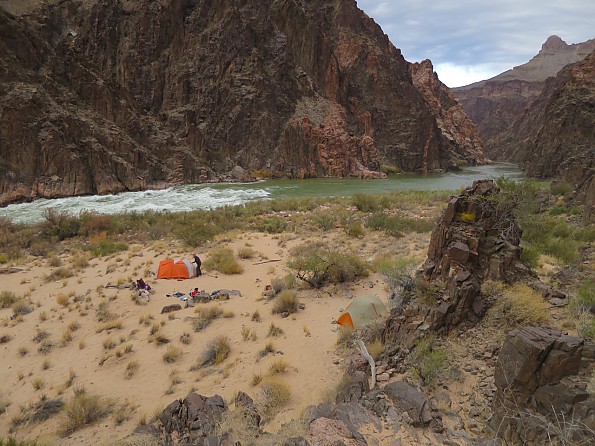Big Agnes Copper Hotel HV UL2
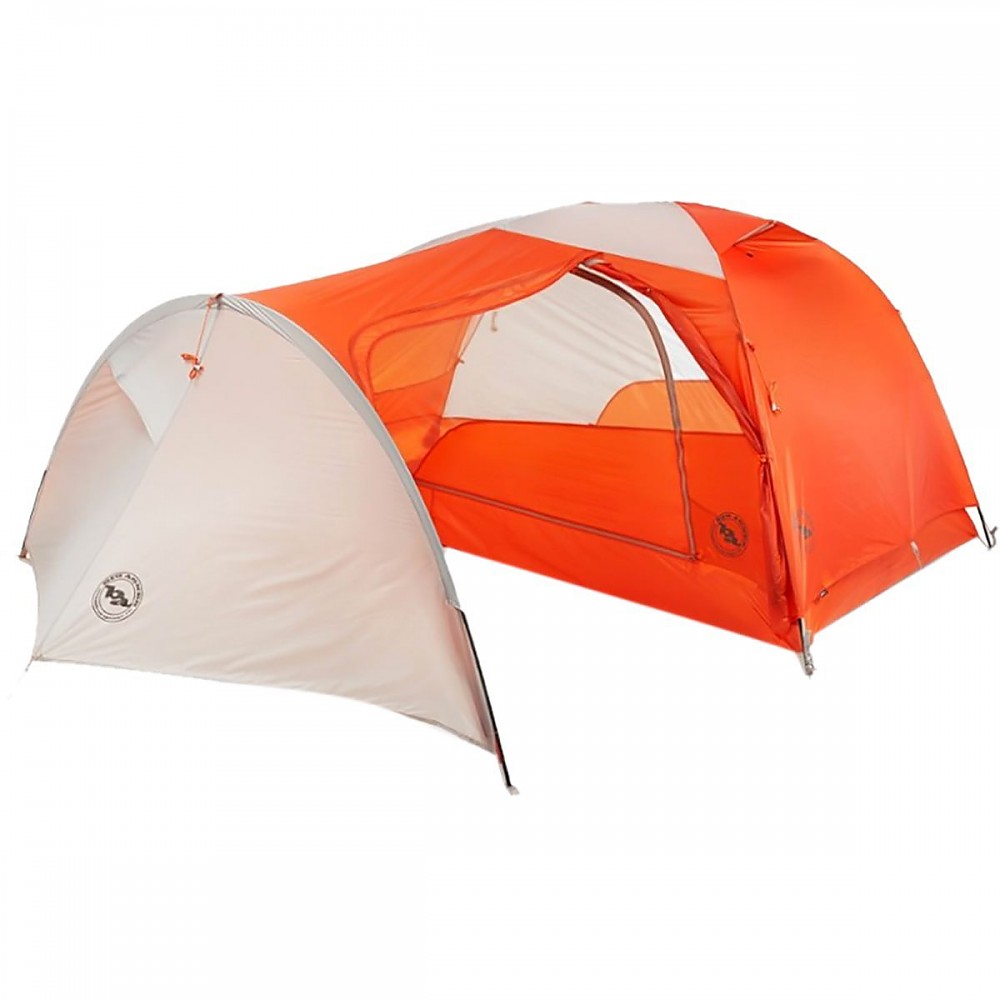
The addition of a huge vestibule to Big Agnes's tried and true Copper Spur series provides a garage for stowing gear, wet dogs, or foul-weather cooking with a minimal weight penalty—great if you need it. Sticky zippers and a little bit too much netting are setbacks.
Pros
- Roomy vestibule for furry friends, foul-weather cooking, or a pile of gear (or a pig)
- Sit-up headroom at both ends
- High volume, vestibule, and floor space-to-weight ratios
- Vestibule design still allows folding back fly for stargazing
Cons
- Sticky zippers often require two hands
- Netting canopy extends to bathtub floor at foot end, lets wind, mist, and grit in
- Should come with at least two more pegs
- What’s up with the orange netting on top?
A few years back I took a four-day hike in the Rondane mountains of Norway with my four-legged buddy Ralph. On day two we exhausted ourselves with a sketchy off-trail traverse over Digeronden, an unstable rock pile greased up with some July snow. When we made camp down in the valley, Ralph was so tired he just sat in camp and watched as I took a little walk over the bridge and down the other side of the river.
Come bedtime he was a warm, dry, and welcome companion in my little two-man tent. 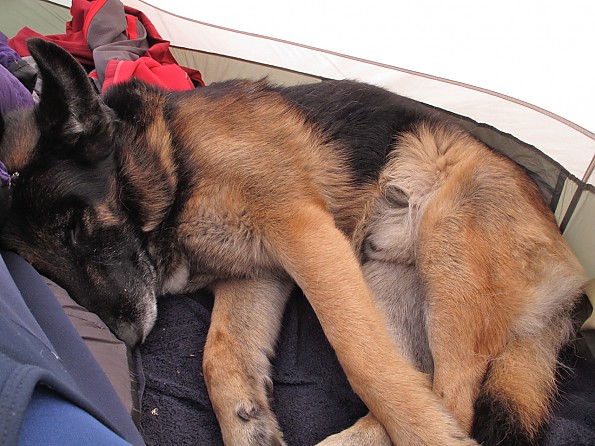
But the next day it rained all day so that a soaking wet Ralph would have been most unwelcome in the tent, which lacked a vestibule of sufficient size for a Pomeranian, never mind a half-breed German shepherd. Instead, we holed up for the night in a hut, a welcome option in Norway.
Well, old Ralphie has since moved on to that great mountain in the sky, so he couldn’t help me test the Big Agnes Copper Hotel HV UL.
He would have dug curling up in its roomy vestibule while the rain pattered on the roof on a recent night out in the Gila Wilderness. A dry place for a soggy doggy may well be the Best and Highest justification for the addition of a huge vestibule to Big Agnes’s successful Copper Spur (hereafter: CS) lineup.
Full disclosure: my wife and I already have a 2014 CS 2 and a 2016 CS 3 in our stable; the 2 wasn’t quite roomy enough for the two of us and it now mostly serves as a roomy solo tent for me. So the Trailspace Review Corp’s offer for us to test drive the Hotel gave us a welcome opportunity to evaluate changes in the CS series, including the addition of a vestibule.
What’s new?
HV stands for High Volume, and reflects an upgrade to previous CS models mainly via a change in pole architecture. A single four-way hub over the peak of the tent replaces the two three-way hubs at either end, giving a stiff crossed-pole architecture for the main frame. The spreader pole now just rests across the longer pair of the hubbed poles and is about 5 cm (2 in) wider than in the old UL2.
A couple of well-placed curves in the poles at the foot end give a lot more headroom, and the sides are more consistently vertical, without the concavities below the spreader that cut into the shoulder room in the middle of the tent on the old model.
 Foot-end view of the 2014 Copper Spur UL2 (left), the new UL2 / Copper Hotel (right)
Foot-end view of the 2014 Copper Spur UL2 (left), the new UL2 / Copper Hotel (right)
To pass a rainy day, I could easily sit up at the head end and my wife at the foot end for a friendly game of cribbage (or some full-contact Scrabble), something that is difficult in our UL2 (but quite feasible in the longitudinally symmetrical 2016 UL3). BA claims a 20% increase in volume over the older model, and I’d say that’s about right. This makes the HV architecture a worthy improvement over its predecessor. It does flatten the roof out a bit, making it less of a performer in snow, but that’s not really what it’s made for.
Weighing in
With the Copper Spur and many of its other backpacker-class tents, Big Agnes carefully balances weight, durability, and living space, honing away at materials while trying to keep the other two elements up to standard. The new architecture doesn’t come with a weight penalty—quite the opposite. The pole bundle + stuff sack for the old model weighs in at 447g (15.7oz), while the bundle for the Hotel minus the weight of the extra vestibule pole is 367 g (12.9 oz), despite a longer overall total pole length in the newer model (about 716 vs. 829 cm). The key is a new generation of DAC aluminum, dubbed Featherweight, which by my calculation comes in at roughly 70% in grams per cm of its predecessor.
Ditto the fabrics used in the body and fly, 510 vs. 310 g (18 vs 11 oz) for the old and new model 2-person tent bodies, respectively, due mainly to proprietary changes in the rip-stop nylon. This detail also shows the spreader pole fitting into a tough webbing pocket in the fly
This detail also shows the spreader pole fitting into a tough webbing pocket in the fly
We’ll have to take their word for it that the new will hold up as well as the old—so far so good on that score after a dozen or so nights of use. Even the pole clips have been pared away, smaller than the old ones but still up to the job. With the vestibule, the complete Hotel in its stuff sack weighs 1692 g vs. 1564 g for our 2014 CS2 and a claimed weight of 1400 g for the updated CS2 (but you can add a few grams for some extra tent pegs—see below). Tarptenters may scoff at those weights, but they are about as good as it gets for a roomy, fully-enclosed shelter, at least at this price point.
About that vestibule…
The pull-out vestibules on the standard CS2 add 0.83 sq m (9 sq ft) triangles of exterior space on each side, enough to stow a pack and a pair of boots for each occupant without interfering with egress, but not enough for a dog of reasonable size. The Hotel vestibule is a whopping 2.5 sq m (27 sq ft), almost as much as the interior 2.7 sg m (29 sq ft). That’s enough room for two dogs of reasonable size, a pile of gear or, in a pinch, one or maybe even two reasonably-sized humans (or maybe or human and a reasonable dog, or a medium-size pig or, well, use your own imagination).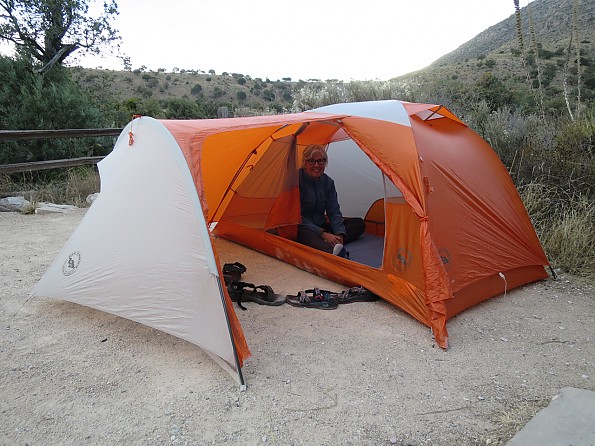
The vestibule is supported by a hoop pole that maintains headroom over much of its width, enough for that reasonable dog to walk right in with the big door zipped open or for a human to sit up inside in a ground-level camp chair. More importantly, with plenty of airspace over a stove, it can allow for reasonably safe cooking in inclement weather. And there’s still room for a pack and boots in the 9 sq ft. of vestibule on the other side. The pole runs through a pole sleeve and, even after some break-in, it takes some muscle, maybe a little too much, to stretch the fabric and fit the end of the pole in the second grommet. A lightweight webbing strap bridges the pole ends so that the fly alone can be pitched using the standard CS2 footprint. That leaves a dirt floor in the vestibule for dogs and stoves.
My biggest gripe is the zipper on the vestibule door. It’s a little sticky and, even with the adjacent corner of the vestibule pegged tight, there’s enough play that the pole lifts when I pull the zipper so that it takes two hands to open it up. But it does open up nice and wide and allows for folding the head end of the fly back for some low-risk stargazing.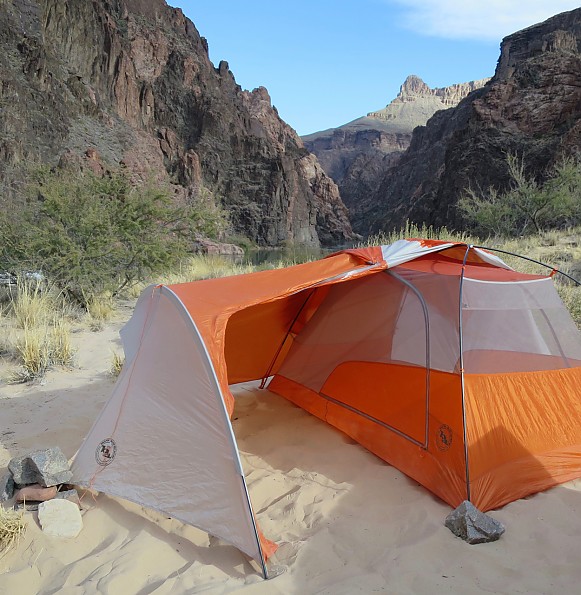 The zipper is double-ended so it can be cracked open on top for a little extra ventilation.
The zipper is double-ended so it can be cracked open on top for a little extra ventilation.
Pitching in
The vestibule makes getting to a satisfactory pitch more complicated as compared to the basic CS models. The core tent is freestanding, but at a minimum the points of the vestibules need to be pegged out and, as with any “freestanding” tent, a taut, wind- and weather-resistant pitch requires some pegging around the perimeter. My current method is to assemble the tent, fly and all, without pegging it down, then I peg out the vestibule apices, the one pulling against the other. Then I go around and peg out other points as needed and as long as the pegs last. This seems to minimize pulling and moving pegs to get everything shipshape.
The basic model CS comes with eight pegs: four for the corners, two for the vestibules, and another pair to pull out the midpoints of the fly away from the tent body at either end. Getting the Hotel vestibule pegged out to my satisfaction would require two more, at either end of the hoop, but BA supplies only the same 8 pegs as in the basic model. In windy conditions, it wouldn’t hurt to have a few more beyond that to peg out the mid-pole guy lines at both ends of the tent. The folded aluminum channel pegs are surprisingly tough. I haven't bent one yet after repeatedly pounding them in to some hard desert soils.
The vestibule is cut to continue the line of the fly around the tent body, ending about 4 inches off the ground. The pullout at the apex of the vestibule isn’t long enough to pull it out at the right angle. It’s also necessary to pull the guy line off the top of the hoop to get the roof line of the vestibule drawn tight. I anchored both with one peg and got a better angle on the bottom edge by anchoring the pullout to the guy line with a little friction knot. That does the job, but I’d rather BA took care of that for me.
Hard to see, but this arrangement gets the vestibule nice and tight with one peg
As in previous models, the pole ends are color coded with matching color webbing around the grommet inserts on the tent body to help tell head from foot. The peg loops are small-diameter nylon cord rather than webbing, presumably as a weight saver. The cord seems to have a little more give than webbing, so that the pole ends can lift a little when trying to unzip the door and vestibule, contributing to the sticky zipper problem. Mid-pole guy lines come ready installed for stabilizing the tent in wind. The cords and the webbing anchors for them are reflective, great for finding a tent in the dark by headlamp but somewhat disturbing in flash photos.
The line tighteners on the guy lines are tiny, but have so far done their job without slippage or breakage. Another small weight-saver.
Fly away home
The fly is anchored to the frame with clips on the four corners and via interior webbing pockets at the ends of the spreader pole. Like the vestibule hoop, it takes a little muscle to stretch the fly and seat the pole in the pockets, but the result is a good snug fit. The peg loops on the tent body are long enough to ensure that the fly does not drip on the corners or anywhere else on the tent body, as long as the midpoints of the fly at the head and foot ends are pulled out.
For windy conditions, and as in many other tents, the fly can be anchored to the poles with Velcro loops to anchor the exterior guy lines to the poles. This takes some fiddling and I don’t look forward to doing it in blowing rain; clips would be better.
Two generous vents, one at the head end and one on the vestibule, allow for some moist air to escape; both can braced open with rigid struts or closed with a Velcro tab. There’s no magic in them, however—like any tent, condensation will build up on the inside of the fly in cold, moist conditions, especially with rain or dew on the outside. It was pretty soggy both inside and out after some night rain on our last outing.
The living room
The floor is slightly trapezoidal, just wide enough for our two 50 cm (20 in) wide mattresses at the foot end and with about 15 cm (6 in) of freeboard on each side at the head.
At 223.5 cm (88 in) lengthwise, it works for all 193 cm (76 in) of me. The bathtub floor wraps up to a height of about 15 cm (6 in) off the ground. Rip stop panels at head and foot and partially along the sides help block wind and dust up to height of about two feet. The rest of the canopy is all no-see-um netting, light gray on the sides and orange on the top. I don’t see that the orange adds much and would rather it was all gray. Inexplicably, to me anyway, the netting runs all the way down to the bathtub floor at the foot third of the tent, allowing a little more wind and grit to penetrate.
That’s from personal experience on a pre-Christmas outing in the Grand Canyon, where we camped in a little dune field by Granite Rapids. Even after we moved into the shelter of a tamarisk, it was a gritty night. Whatever the weight penalty, I’d much rather have 60 windproof cm (24 in) all around. All the new CS models have this flaw (in my opinion); the old CS Classic tents are still on the BA website at somewhat reduced prices and still have a wind barrier all around, but are heavier than the new models.
There are netting stash pockets by the sleepers’ heads and a full-width pocket on the end wall overhead, the latter with corner cutouts for earbud wires for those so inclined. Loops opposite the upper pole clips allow for hanging a lantern or gear loft.
What's up with the carrot top?
One of my favorite features of CS tents (and those of many other brands) is the his and her side doors. No more crawling in and out the head end on hands and knees, doing a 180 butt-spin to get your feet out the door, or getting flailed by your partner as she does the same.
However much the extra zippers weigh, it’s worth it. In the new model tent body, the door opens via two single-pull zippers (a change from the double-pull zipper and drop down door on older models), one horizontal along the bottom and the second curved up over the top.
Like the vestibule zipper, the door zippers can be a bit sticky. They meet by the sleeper’s head. I like this arrangement because the zipper sliders are always in the same place and so easy to find in the dark, but it does mean that opening the curved zipper requires an upward pull, contributing to the sticky zipper problem.
Best for…
To be honest, since we are spending a year in the desert, and don’t currently have a dog, we haven’t yet found the vestibule all that useful. But we’ll probably be looking for a pup when we get back to Norway, and it rains a whole lot more there. Camping with a dog in the rain—something to look forward to.
This would be a great tent for longer trips for two where weight matters, where there is some probability of wanting to cook in the rain, and/or with a dog or two along. At MSRP the Hotel costs about $100 more than the UL2, the main difference being the big vestibule, so with the price and weight increase you want to have good reason to have that vestibule. The current edition of the UL3 falls about halfway in between on both fronts, provides a lot more interior space for two, and still has the twin small vestibules, and so might well be a better choice for the dogless.
I wouldn’t be excited about using it in really windy conditions, the more so because of the extended netting at the foot end. Not that it won’t hold up if properly stabilized, I just think the wind and accompanying dust and moisture will find its way in. I haven’t used it in snow, but I would expect there to be some build up on the flattish ridge line of the fly, probably OK for an autumn or spring dusting but not much more. Note that as of this writing both older models are still available as “Classics”. They are heavier than the new equivalents but have a ripstop wind barrier all around and so might be a better choice for windy environments, while they last.
It’s common for midweight hikers to use a light two-person tent as a roomy shelter for one, but the vestibule would probably be overkill for that purpose, unless your partner happens to be a soggy doggy.
Test conditions
By my count we’ve spent 15 nights in this tent, including one with a light shower and another with more continuous rain, at temperatures down to the upper 20s F. And there was that windy afternoon and night in the sand at Granite Rapids. No dogs or pigs were harmed in this test.
Addendum
With all three tents stored away in the cave, I gave into the temptation to do a weight comparison between those three and the the other HV UL models while I was at it.
Source: received for testing via the Trailspace Review Corps
(Sample provided by Big Agnes for testing and review)
Your Review
Where to Buy
You May Like
Specs
| Price |
MSRP: $529.95 Historic Range: $274.98-$549.95 |
| Trail Weight |
2lb 11oz / 1.22kg |
| Total Weight |
3lb 2oz / 1.42kg |
| Packed Size |
19.5 x 6 in / 50 x 15cm |
| Floor Area |
29 ft² / 2.7 m² |
| Vestibule Area |
9ft² + 9ft² / 0.8 m² + 0.8 m² |
| Head Height |
40 in / 102cm |
| Fast Fly / Shelter Mode Weight |
2lb 2oz / 964g |
| Footprint Weight |
5oz / 142g |




